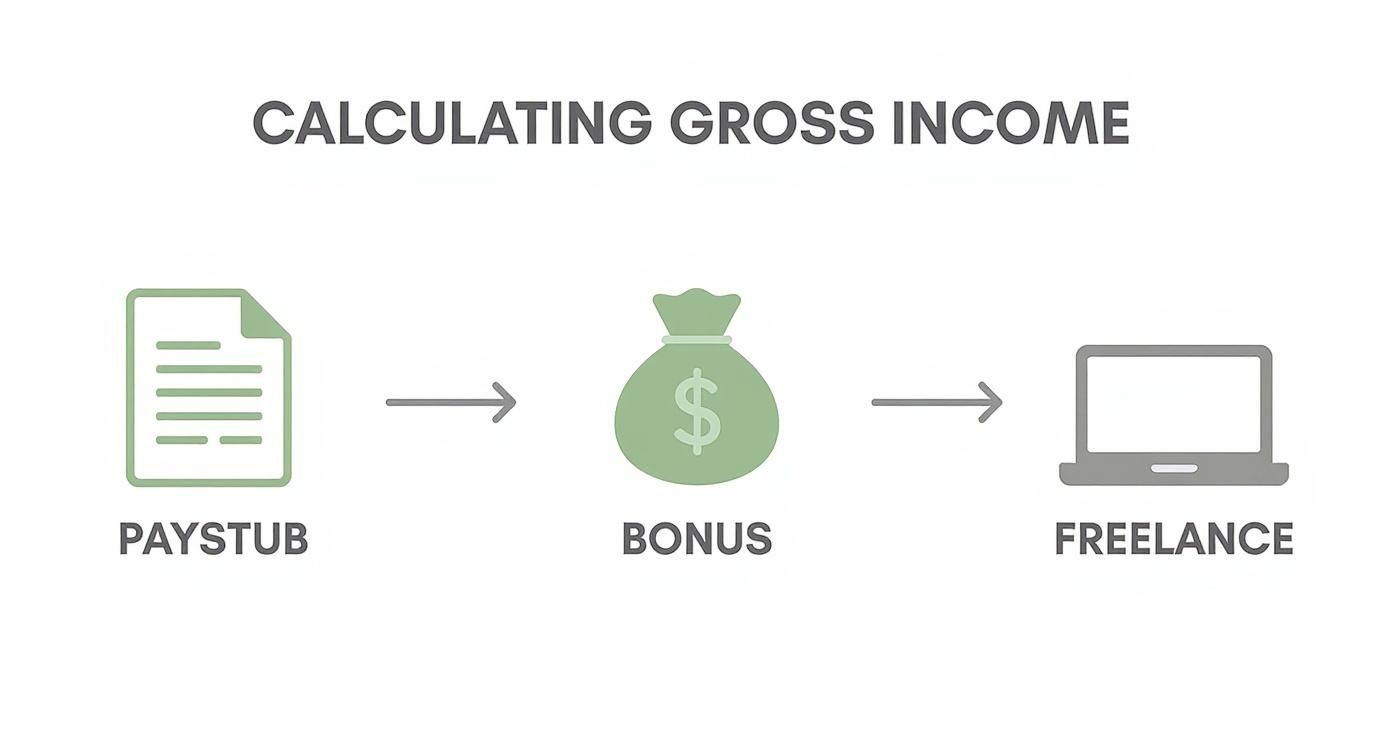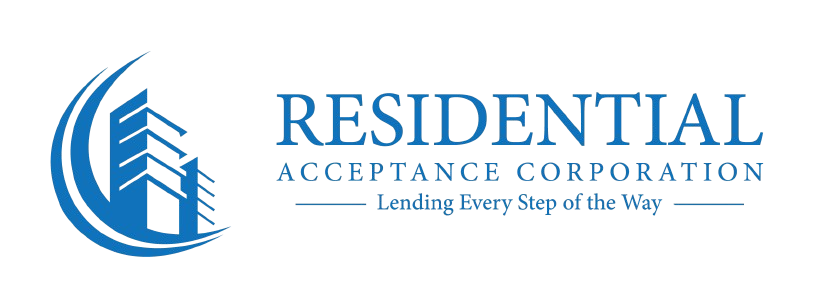Your debt-to-income ratio, or DTI, is a pretty straightforward calculation. You just divide your total monthly debt payments by your gross monthly income. That's it.
But this one number, shown as a percentage, is a huge deal to lenders. It's their go-to metric for figuring out if you can really handle a new mortgage payment on top of everything else you already owe. Getting a handle on this calculation is your first real step toward buying a home in Tampa.
What DTI Means for Your Tampa Mortgage Approval

When you're trying to buy a home, especially in a fast-paced market like Tampa, your DTI ratio is one of the most important numbers in the whole process. It shows a lender, like us at Residential Acceptance Corporation (RAC Mortgage), exactly what slice of your pre-tax income is already spoken for by existing debts.
A lower DTI sends a clear signal: you've got a healthy financial situation.
This single percentage gives us a quick snapshot of your financial life. It helps us gauge whether you can comfortably take on a new mortgage without stretching yourself too thin. In a competitive market like Tampa's, a strong DTI can seriously make your application pop.
So, Why All the Fuss About DTI?
Lenders are practically obsessed with DTI because it's one of the most reliable predictors of whether a borrower can keep up with their payments. It cuts right to the chase and answers the big question: "Can this person afford another monthly bill?"
Here's why it carries so much weight:
- It’s a direct measure of your ability to repay. There’s no ambiguity. DTI shows your capacity to take on new debt, plain and simple.
- It’s a major factor in loan approval. A DTI that's too high is one of the most frequent reasons we see for a mortgage application getting denied.
- It can even impact your loan terms. Coming to the table with a lower, more attractive DTI might help you lock in a better interest rate.
A good DTI ratio is more than just a number for a form. It’s a testament to your financial health and a cornerstone of a convincing mortgage application. It proves you're a responsible borrower.
Ultimately, your DTI sets the stage for how much you can borrow. Before you even start scrolling through Tampa home listings, you need to know this number. It’s a fundamental piece of the puzzle and a crucial part of figuring out how to get preapproved for a mortgage.
Tracking Down Your Monthly Debt Payments

To get an accurate debt-to-income ratio, you have to put on your detective hat for a bit. This means hunting down every single recurring monthly debt payment a lender will be looking at. It’s all about getting the raw numbers right from the start so you don’t run into any surprises when you apply for that mortgage in Tampa.
Trust me, lenders like Residential Acceptance Corporation (RAC Mortgage) are going to verify every one of these figures, so precision is everything. This isn't the time to guesstimate. The best way to start is by pulling together all your recent financial statements—both paper and digital—to create one master list.
This idea of measuring what you owe against what you have isn't just for individuals. It actually scales all the way up to entire countries. For nations, the equivalent is the debt-to-GDP ratio, which compares a country's total debt to its economic output. Japan, for example, has one of the highest ratios in the world at around 255%, a number that tells a story about its economic history.
Identifying Every Debt Payment
When you start adding up your debts, you have to think like a lender and go beyond the most obvious bills. Your list needs to include the minimum required payment for any liability that shows up on your credit report.
Here’s a quick checklist to make sure you don't miss anything:
- Housing Payments: This is either your current mortgage payment or your monthly rent.
- Auto Loans: Tally up the payments for any cars, trucks, or motorcycles you're financing.
- Student Loans: Include the required monthly payment for all your federal and private student loans.
- Credit Cards: You’ll need the minimum monthly payment for every single credit card—even the ones you pay off in full each month.
- Personal Loans: Add any payments for unsecured loans from banks, credit unions, or online lenders.
- Other Installment Loans: Think about financing for furniture, electronics, or other big-ticket items.
Getting these details organized is a huge part of the mortgage process. Having your paperwork in order helps everything run smoothly. You can see a full breakdown by reviewing the list of documents needed for a mortgage application.
Quick tip from experience: Lenders always look at the minimum required payment printed on your statements, not what you actually choose to pay. If your credit card bill says the minimum is $50, that’s the number we have to use, even if you’re a rockstar who always pays $200.
Calculating Your Gross Monthly Income
Now for the other side of the equation: your gross monthly income.
This isn't just your take-home pay. It’s the total amount you earn before any taxes, insurance premiums, or 401(k) contributions come out. Lenders like us at Residential Acceptance Corporation (RAC Mortgage) look at this pre-tax number because it gives us a standardized, complete picture of your earning power.
If you're a salaried employee, this part is pretty simple. Just grab your latest pay stub. But for many Tampa residents with more dynamic income streams, it takes a little more legwork to pull this figure together.
What Counts as Income
Lenders need to see income that’s both stable and reliable. This means you’ll need to have the right paperwork to back up every source of income you want us to consider.
Common types of verifiable income include:
- Wages and Salary: Your regular pay from your primary job.
- Bonuses and Commissions: If these are a consistent part of your pay, they can often be included.
- Overtime Pay: Similar to bonuses, it needs to have a reliable track record.
- Freelance or Self-Employment Earnings: This is a big one for entrepreneurs and business owners in the Tampa area.
Figuring out the documentation for varied income can feel like a maze, especially if you run your own business. For a closer look, you can learn more about how a trusted Tampa mortgage lender for self-employed individuals handles this exact situation.
Lenders will typically ask for two years of tax returns and your most recent pay stubs to verify your income. Having this paperwork organized and ready to go can seriously speed up your mortgage application.
Let's take an hourly worker here in Tampa as an example. We might average their hours over several pay periods to establish a dependable monthly income. If you earn $20 per hour and consistently work a 40-hour week, your weekly gross is $800.
To get the monthly figure, you'd multiply that by 52 weeks and then divide by 12 months, giving you a gross monthly income of $3,466.67. This is the number you’ll plug into your DTI calculation.
Putting It All Together: The DTI Calculation
Alright, you've done the legwork. You've tallied up your monthly debts and figured out your gross monthly income. Now it's time for the moment of truth—running the actual debt-to-income calculation.
This is the exact same math a mortgage lender uses to get a snapshot of your financial health. The formula itself is refreshingly simple.
It breaks down like this: (Total Monthly Debts ÷ Gross Monthly Income) x 100 = DTI %
This little formula is incredibly powerful. It takes all those numbers from your paystubs and bills and boils them down into a single percentage that we, as lenders at Residential Acceptance Corporation (RAC Mortgage), look at very closely when reviewing your loan application.
A Tampa Homebuyer Example
Let's make this real. We'll use a hypothetical scenario for someone looking to buy a home right here in the Tampa area.
Imagine your total household income, before any taxes or deductions are taken out, is $7,500 per month.
After adding up all your minimum monthly payments—car loan, student loans, credit cards—your total monthly debt comes out to $2,400.
Here’s how we'd calculate the DTI:
- First, divide your total debts by your total income: $2,400 ÷ $7,500 = 0.32
- Then, turn that decimal into a percentage: 0.32 x 100 = 32%
In this situation, your DTI is 32%. To a lender, this number says that for every dollar you earn, about 32 cents is already spoken for by existing debt. Frankly, that’s a pretty strong position to be in when you're applying for a mortgage in Tampa.
The infographic below gives you a good visual on all the different income sources you would have gathered to get to that $7,500 figure—it’s not always just a simple paycheck.

It’s a great reminder to account for every dollar coming in, whether it’s from your main job, a side hustle, or other sources, to get the most accurate picture of your income.
Understanding this hands-on calculation demystifies the lending process. It’s not an arbitrary number but a clear reflection of your monthly cash flow, showing exactly how much room you have for a new mortgage payment.
Once you get comfortable calculating your DTI, you may also benefit from mastering other debt-related financial ratios, such as the debt-to-asset ratio, which can give you an even broader look at your overall financial standing.
What Your DTI Ratio Tells Lenders
So, you've crunched the numbers and have your final DTI percentage. What does that number actually mean to a mortgage lender here in Tampa?
Think of it as a snapshot of your financial bandwidth. It’s a direct indicator of how much room you have left in your budget to comfortably take on a new—and significant—monthly mortgage payment.
Here at Residential Acceptance Corporation (RAC Mortgage), we see it as a measure of your capacity to manage new debt responsibly. A lower DTI is a great sign. It tells us you have plenty of cash flow after your current bills are paid, which makes you a less risky borrower. On the flip side, a higher DTI signals that a large chunk of your income is already spoken for, which could make handling a new mortgage a real challenge.
Front-End vs. Back-End DTI Ratios
To get the full story on your finances, lenders often look at your DTI in two different ways:
- Front-End DTI: This one is simple. It only looks at your potential housing costs—your future mortgage principal, interest, property taxes, and homeowners insurance (we call this PITI).
- Back-End DTI: This is the big one we've been focused on. It’s the more comprehensive number, including your future housing costs plus all your other existing monthly debts like car loans, student loans, and credit card minimum payments.
While both numbers are useful, your back-end DTI is the primary figure we use for most lending decisions because it shows us your total debt load.
Key DTI Benchmarks for Tampa Homebuyers
Generally speaking, the lower your DTI, the better your shot at getting a loan with great terms. Lenders tend to look for a few key thresholds.
36% or Lower: This is the sweet spot. It shows lenders you have a solid handle on your finances and plenty of breathing room in your budget.
43%: This is often the highest DTI a borrower can have and still qualify for many conventional loans.
50% or Higher: Getting a mortgage with a DTI in this range isn't impossible, but it gets tricky. Some government-backed programs might allow for a DTI above 43%, but you’ll likely need strong "compensating factors," like an excellent credit score or a big pile of cash reserves.
Knowing these benchmarks helps you understand exactly where you stand. It's a big deal, especially when you consider that global debt hit a staggering $251 trillion in 2024. For more on borrower rights and how lenders make their decisions, check out the CFPB guidelines on credit denial explanations.
Common DTI Questions for Tampa Homebuyers
When you're navigating the Tampa home loan process, a few key questions about the debt-to-income ratio always seem to pop up. Getting a handle on the finer points can honestly make all the difference as you get your finances in order.
One of the first things people ask is what gets left out of the DTI formula. It's a great question. You only need to worry about the debts that show up on your credit report. Your day-to-day living costs—things like groceries, your electric bill, your cell phone, or car insurance—are not factored in. Lenders are laser-focused on the required minimum monthly payments for your loans and credit lines.
Can You Get a Mortgage with a High DTI?
This is another big one. People worry that a high DTI is an automatic deal-breaker for getting a mortgage in Tampa. The short answer is: not always.
While a lower DTI definitely makes things easier, some loan programs have more wiggle room. Lenders like Residential Acceptance Corporation (RAC Mortgage) can often find a path to approval for applicants with higher ratios, especially if they have other strengths. We call these "compensating factors," and they could be anything from a larger down payment and a great credit score to having a healthy amount of cash in savings.
If your DTI is a bit higher than you’d like, don't panic. You can take some real, practical steps to improve it, sometimes faster than you'd think.
- Chip Away at Your Balances: Zero in on paying down credit card balances or personal loans. Every little bit helps, and even small reductions in your total debt can nudge your DTI in the right direction.
- Put a Pause on New Debt: This is crucial. Hold off on financing a new car, furniture, or any other major purchase until after your home loan has closed.
- Show All Your Income: Make sure you document every penny you earn. Consistent overtime or even a steady side hustle can give a nice boost to the income side of the DTI equation.
Knowing where you stand financially is empowering. When you calculate your DTI before talking to a loan officer, you walk in with a clear picture and can pinpoint exactly what you need to work on before you even apply.
Getting your DTI in shape is one of the most powerful moves you can make toward securing your dream home right here in Tampa.
Ready to take the next step in your Tampa homebuying journey? The expert team at Residential Acceptance Corporation is here to guide you through your financing options and help you understand your DTI.
Start Your Mortgage Application with RAC Today

